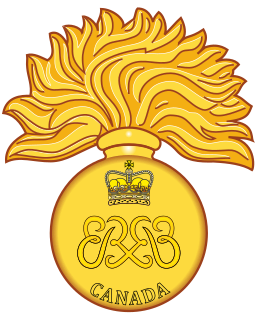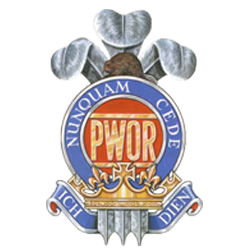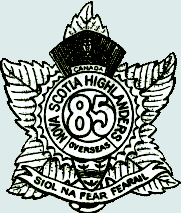Related Research Articles

The Royal Canadian Regiment is an infantry regiment of the Canadian Army. The regiment consists of four battalions, three in the Regular Force and one in the primary reserve. The RCR is ranked 1st in the order of precedence amongst Canadian Army infantry regiments, but in a quirk of the rules of seniority, its 4th battalion is 9th.

The Canadian Grenadier Guards (CGG) is a reserve infantry regiment in the 34 Canadian Brigade Group, 2nd Canadian Division, of the Canadian Army. The regiment is the oldest and second-most-senior infantry regiment in the Primary Reserve of the Canadian Army. Located in Montreal, its primary role is the provision of combat-ready light infantry troops in support of Canadian regular infantry. It is a Household Foot Guard regiment and also provides soldiers for public ceremonial duties, performing similar ceremonial duties to the Guards regiments of the British Army. This primarily entails mounting the guard on Government House, the Governor General's residence, and performing the "Changing the Guard" ceremony on Parliament Hill in Ottawa, a task it shares with Canada's senior Household Foot Guard regiment, the Governor General's Foot Guards of Ottawa. The Canadian Grenadier Guards is an allied regiment to the British Grenadier Guards.

The Royal Hamilton Light Infantry (RHLI) is a Primary Reserve infantry regiment of the Canadian Army, based at John Weir Foote VC Armoury in Hamilton, Ontario. The RHLI is part of 31 Canadian Brigade Group, which is part of 4th Canadian Division.

The Argyll and Sutherland Highlanders of Canada , or A & SH of C, is a Primary Reserve Highland infantry regiment of the Canadian Forces, based at John W. Foote VC Armoury in Hamilton, Ontario.

The Princess of Wales' Own Regiment (PWOR) is a Primary Reserve infantry regiment of the Canadian Forces.

The Hastings and Prince Edward Regiment is a Primary Reserve infantry regiment of the Canadian Army. The regiment is part of 33 Canadian Brigade Group, one of four brigade groups of 4th Canadian Division. The regimental headquarters and one company are located at 187 Pinnacle Street in Belleville, with additional companies in Peterborough and Cobourg. The Peterborough Armoury houses what was traditionally B Company or Moro Company, and C Company or Cassino Company is housed in an industrial mall unit on Willmott Street in Cobourg. Normally, the regiment deploys as a composite, Ortona Company, while the headquarters and administration form Somme Company.

The Lorne Scots is a Primary Reserve infantry regiment of the Canadian Army. It is part of the 4th Canadian Division's 32 Canadian Brigade Group.

The Brockville Rifles is a Primary Reserve infantry regiment of the Canadian Army. The unit is a part of the 33 Canadian Brigade Group, 4th Canadian Division. It is fifteenth in the order of precedence of Canadian Army Infantry Regiments.

The Essex and Kent Scottish is a Primary Reserve infantry regiment of the Canadian Army.

The 20th Battalion, CEF was a unit of the First World War Canadian Expeditionary Force.
The 205th (Tiger) Battalion, CEF was a unit in the Canadian Expeditionary Force during the First World War. Established in late 1915, it was stationed in Hamilton, Ontario and began recruiting toward the end of February 1916. In late 1916, the unit was redesignated a machine gun battalion, but a few months later, in April 1917, the 205th (Tiger) Battalion was broken up for drafts. One company was transferred to the 164th Battalion, CEF, which was recruiting in nearby Halton County. The unit continued to exist as the 205th Machine Gun Depot and then the 205th Machine Gun School.
The 173rd (Highlanders) Battalion, CEF, was a unit in the Canadian Expeditionary Force during the First World War. One of a number of Highlander battalions in the Canadian Expeditionary Force, it was based in Hamilton, Ontario, and began recruiting during the winter of 1915/16.
The 125th Battalion, CEF was a unit in the Canadian Expeditionary Force during the First World War.
The 126th Battalion (Peel), CEF was a unit in the Canadian Expeditionary Force during the First World War. Based in Toronto, Ontario, the unit began recruiting in late 1915 in Peel County. After sailing to England in August 1916, the battalion was absorbed into the 109th and 116th Battalions, CEF, and the 8th Reserve Battalion on October 13, 1916. The 126th Battalion (Peel), CEF, had one Officer Commanding: Lieut-Col. F. J. Hamilton.
The 129th (Wentworth) Battalion, CEF was a unit in the Canadian Expeditionary Force during the First World War. Based in Dundas, Ontario, the unit began recruiting in late 1915 in Wentworth County. After sailing to England in August 1916, the battalion was absorbed into the 123rd and 124th Battalions, CEF and the 12th Reserve Battalion in October 1916. The 129th (Wentworth) Battalion, CEF had one Officer Commanding: Lieut-Col. W. E. S. Knowles.
The 164th Battalion, CEF, was a unit in the Canadian Expeditionary Force during the First World War. Based in Orangeville, Ontario, the unit began recruiting in late 1915 in Halton and Dufferin Counties.

The 85th Battalion, CEF, was an infantry battalion of the Canadian Expeditionary Force during the Great War. The 85th Battalion was authorized on 14 September 1915 and embarked for Great Britain on 12 October 1916. Disembarking in France in February 1917, it fought as part of the 12th Infantry Brigade, 4th Canadian Division in France and Flanders until the end of the war. The battalion is most famous for capturing Hill 145 in their first battle. Today, the Vimy Memorial stands on Hill 145.
The 86th Battalion, CEF was an infantry battalion of the Canadian Expeditionary Force, which was raised for overseas service during World War I. Authorized on December 22, 1915, the battalion embarked for Britain in May 1916. Based at Shorncliffe, the battalion was reorganized as the Canadian Machine Gun Depot, CEF and provided reinforcements for Canadian units in the field until it was disbanded on 1 September 1917. It is believed to have been "the first of its kind in the British Empire."
4th Battalion, CEF was an infantry battalion raised as part of the Canadian Expeditionary Force for service during the First World War. Raised in Canada in September 1914, the battalion sailed to the United Kingdom within weeks of its establishment. After a short period of training it was committed to the fighting on the Western Front, remaining in France and Belgium until the war ended. It returned to Canada in mid-1919 and after its personnel had been demobilized, the battalion was subsequently disbanded in 1920.
The Wentworth Regiment was an infantry regiment of the Non-Permanent Active Militia of the Canadian Militia. In 1936, the regiment was Amalgamated with The Royal Hamilton Light Infantry to form The Royal Hamilton Light Infantry.
References
- ↑ Fearman, George Douglas. "Officers' Declaration Paper". Library and Archives Canada . Retrieved 2006-06-03.
- ↑ Canadian Forces Publication A-DH-267-003 Insignia and Lineages of the Canadian Forces. Volume 3: Combat Arms Regiments.
Meek, John F. Over the Top! The Canadian Infantry in the First World War. Orangeville, Ont.: The Author, 1971.